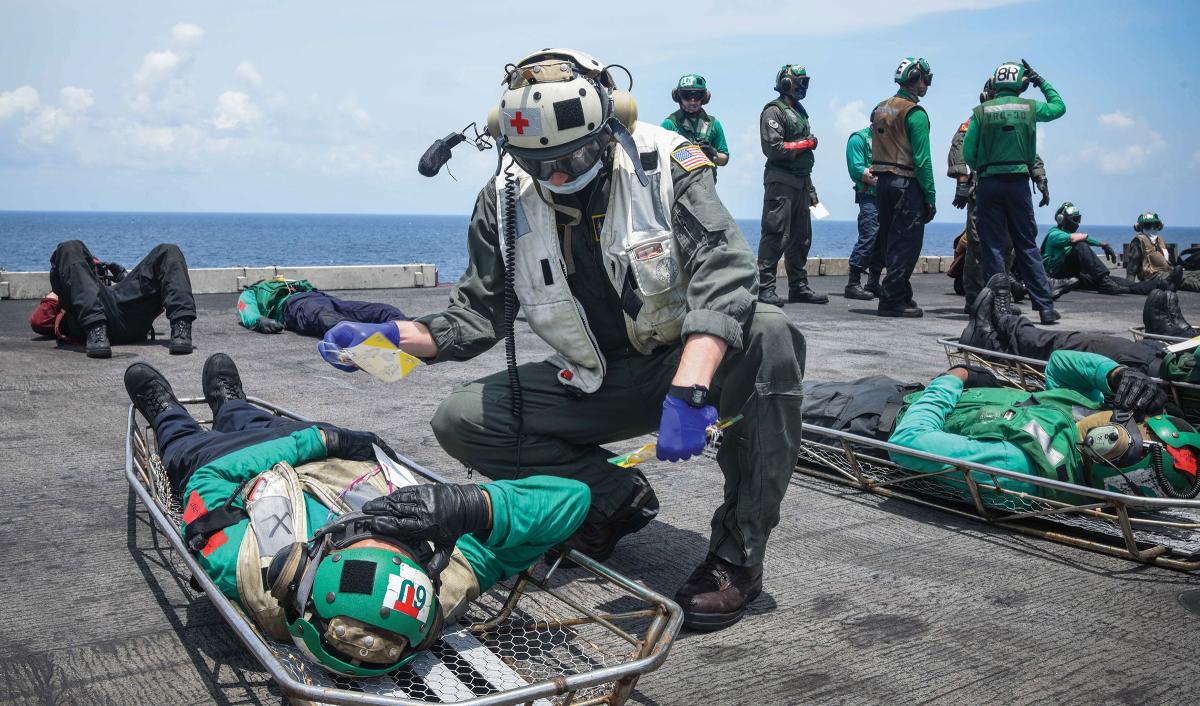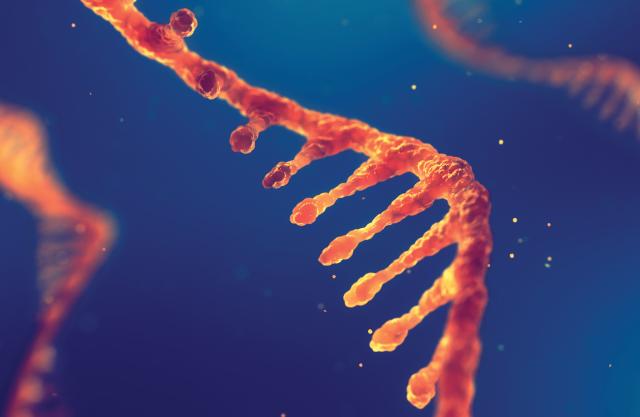The COVID-19 pandemic has revealed critical weaknesses in the human domain of warfare at just the moment technology has emerged that gives bad actors new power to exploit those weaknesses. Developments in synthetic biology will create next-generation bioweapons, “human-domain fires” that will fundamentally change the strategic environment and create a threat naval planners must consider now, before it is encountered at sea.
A Human-Domain Plague
In a March 2020 press release praising the effectiveness of its preventative medicine, the Navy proudly declared: “No cases of COVID-19 have been diagnosed aboard any U.S. 7th Fleet Navy vessel.”1 One week later, cases were spreading so rapidly, the USS Theodore Roosevelt (CVN-71) effectively became a “mission-kill.”
COVID-19 has demonstrated that biological threats are almost entirely unaffected by sophisticated kinetic, cyber, and electromagnetic defenses. The French aircraft carrier Charles de Gaulle reported in April 2020 that 60 percent of her crew was infected with COVID-19. French Admiral Christophe Prazuck warned “that the [medical] measures onboard were ‘obviously circumvented’ by a ‘stealthy, insidious virus.’”2 It can be debated whether the U.S. or French carriers would have stayed in the fight if COVID-19 had broken out during wartime. But a more lethal, deliberately devised, weaponized agent could eviscerate a fleet.
This socially transmitted vector is characteristic of a critical military dimension. The human domain, which the Department of Defense says “consists of the people (individuals, groups, and populations) in the environment, including their perceptions, decision-making, and behavior,” is a key component of the operating environment.3 Maritime, air, land, cyber, and information activities all affect this space, seizing psychological and behavioral “terrain” in a form of human-domain maneuver. This terrain comprises individuals, networks, and communities linked by ideology or association, frequently spread across and informed—but not limited—by geography. Traditionally, this has been maneuver terrain, a place to “win hearts and minds.” But new technology means fires in the human domain—biological fires especially—can now affect other domains, circumventing conventional defenses to find, fix, and finish targets with unnatural effect.
Recent developments in synthetic biology—which the National Academy of Sciences defines as “concepts, approaches, and tools which enable the modification or creation of biological organisms”—pose a profound threat.4 Humans first edited organisms through husbandry and botany—imprecise, indirect processes that required years to centuries to achieve much. Polymerase chain reaction (PCR) was developed in 1985 and allowed DNA from one organism to be isolated, copied, and inserted into another in the first form of widely used genetic modification. A newer technique, clustered regularly interspaced short palindromic repeat (CRISPR-Cas9), was first harnessed for genetic editing in 2013.5 Compared with PCR, CRISPR-Cas9 is cheaper, faster, and more accurate—a development likened to replacing vacuum tubes with transistors in the early days of computing.
It is much easier to use than PCR, too. CRISPR uses RNA (genetic information similar to DNA but which functions as a messenger within a cell) and the Cas9 enzyme to edit the genes. Biologists use the RNA to identify a sequence for removal or insertion and Cas9 to do the actual cutting and splicing.6 One 2019 winner of the International Genetically Engineered Machine competition was a team of high school students who engineered E. coli bacteria to spin spider silk.7 With CRISPR, to do the editing you simply have to know what genes control spider silk production and possible places to put them on the bacterial genome. With constant development, the technical obstacles to designing completely new traits and inserting them in designer organisms will only decrease. The opportunities and dangers are nearly limitless.
Choose Your Weapon
Of those dangers, next-generation bioweapons are the most serious. Unlike traditional bioweapons, which most states have abandoned as unreliable, synthetic bioweapons (SBWs) are weaponized biological threats modified through synthetic biology for novel effects, mechanisms, or processes.8 Unshackled from natural biology, SBWs possess characteristics engineered to target populations or individuals, through socially transmitted rather than kinetic means. Although each of the military services and the entire U.S. population could be at risk from SBWs, the nature of the Sea Services’ operations—far from home but necessarily dependent on local goods and services in forward-deployed locations—places them at particular risk.
George Mason University’s Gregory D. Koblentz says, “Biological warfare favors the attacker.”9 One possible use of synthetic bioweapons would be to neutralize a ship or task force preemptively, before any active conflict, incapacitating a crew instead of killing it. A tailored incubation period or high presymptomatic transmission can be a matter of planning rather than luck. Programmed obsolescence, by which a disease dies after a set number of generations or fails to transmit in nontarget environmental conditions, can protect the attacker. Chinese People’s Liberation Army (PLA) Senior Colonel Guo Ji-Wei refers to this effect as “multiple vulneration,” the idea that overlapping biological effects can aid targeting.10
“Binary weapons” are paired infections separated to evade detection that can later combine for desired effect.11 Complementary, harmless viruses released in San Diego and Guam could synthesize, in a host exposed to both, to generate a debilitating illness. Such covert SBW fires could take a whole strike group off the board shortly before China launched an invasion of Taiwan, for example.
One threat that was once the stuff of science fiction may soon become real. Some researchers (including Lieutenant General Zhang Shibo, former president of the PLA National Defense University) foresee the possibility of “specific ethnic genetic attacks” on whole racial or ethnic groups, although there remain political and scientific obstacles at present.12 A unique person with unique genes is easier to target than population-level differences in the nearer term. SBWs with high levels of asymptomatic transmission could pass from host-to-host through the human domain, until reaching a vulnerable target or targets possessing the “right” genes. (Procuring a president or admiral’s DNA is easy. Simply invite the target to dinner at a venue you control.)
And China may already have hacked from medical records or purchased the genetic information of millions of ordinary Americans through genealogical companies such as 23andme.13 Bill Evanina, former director of the National Counterintelligence and Security Center, warned against Beijing Genomics Institute–linked COVID-19 tests, noting: “Foreign powers can collect, store and exploit biometric information from COVID tests.”14
Potential SBW effects include not only incapacitation and death, but also boutique outcomes. Colonel Guo emphasizes that “learning, memorizing . . . and even the ‘bellicose character’ can be injured precisely without a threat to life.”15 Making an adversary’s leader docile (or erratic, confused, or hyper-aggressive) might be as effective as a kinetic decapitation strike. Further, the ability to reach and nonlethally modify a target creates opportunities for coercion. A compellent threat creates conditions to force change in an adversary’s behavior. The ability to remotely hold a person’s biology hostage—through degenerative, frustrating, or simply embarrassing symptoms—but promising a personal cure (or enhancement) could create enormous strategic leverage.
Warfare Beyond Rules
Doctrinally, China has recognized the critical role the human domain will play, and some Chinese thinkers have already rejected moral limits on SBWs. In 1999, PLA Colonels Qiao Liang and Wang Xianghui published Warfare Beyond Rules, a treatise on asymmetric conflict that advocates for “warfare beyond all boundaries and limitations.” Qiao and Wang emphasize that China must be prepared to synchronize all government capabilities at all levels of competition, with all tools considered legitimate. These include: conventional, “biochemical,” “ideological war,” and other means of conflict.16
In this framework, chemical and biological weapons “are nothing more than nontraditional weapons whose mechanisms have been altered and whose lethal power and destructive capabilities have been magnified several times over.”17 With nothing inherently immoral in their use, “new concept weapons” such as SBWs are evaluated strictly on military utility.18 The work received high-level praise within China—Qiao was promoted to major general, and he and Wang still shape the next generation as national security lecturers.19
PLA Lieutenant General He Fuchu, vice president of the Chinese Academy of Military Science (AMS), has emphasized that “biotechnology [is] a new ‘strategic commanding heights.’” His agency’s 2017 Science of Military Strategy defined biology “as a domain of military struggle.”20 Such trains of thought culminate in new weapons perfectly suited for “warfare beyond rules.”
Mounting a Response
U.S. reactions to synthetic biology attacks will be fraught with difficulties in attribution, signaling, and response. The traditional U.S. position on chemical or bioweapon use has linked any potential response to the nuclear deterrent, through the 1998 doctrine of calculated ambiguity. But Syria’s unanswered mass use of chemical weapons (and North Korea and Russia’s highly targeted use) has destroyed the credibility of threats of a nuclear response to all use of weapons of mass destruction.21
Indeed, attributing such an attack would be difficult in any case. The 1975 Biological and Toxic Weapons Convention outlawed the acquisition and stockpiling of all forms of biological weapons but lacked inspection or enforcement regimes. As the slow initial response to COVID-19 demonstrates, it takes time to recognize a new threat, understand it, identify its origin, and develop medical countermeasures. The characteristics of SBWs that make them so attractive to bad actors also magnify the challenges of reacting. Mustering the evidence to attribute the source of an attack and generate broad public support and political will for a vigorous response would be difficult, to say the least.
Given these barriers, what should the Sea Services do? First, investment in military biodefense is critical. This requires enhancing threat awareness by developing a global biothreat common operating picture (BioCOP) in coordination with national and international defense, public health, homeland security, and intelligence agencies. A BioCOP must be able to recognize and characterize SBWs through active bio-surveillance in vessels, ports, and facilities, with special attention for globally dispersed, binary weapons. Second, research organizations, such as the Defense Advanced Research Projects Agency’s biotechnology office, need the resources to drive development of advanced biosensors, diagnostics, countermeasures, and other defenses to keep pace with changes in synthetic biology. National biodefense must not be exclusively reactive. A comprehensive counter-SBW plan would look for and respond to clear and present synthetic biologic dangers while advancing the country’s knowledge about potential and emerging threats.
The government as a whole and the individual services in particular must develop flexible and muscular response plans that include well-maintained stockpiles of specialized sensors and protective equipment. Defensively, lessons learned from COVID-19 social distancing should inform reactions to SBW fires and associated doctrine. The federal government must assess, determine, and message what a proportional response to various levels of SBWs would be. These efforts should feature in military wargaming and principal-level exercises, with appropriate effort spent in developing and signaling tactical, operational, and strategic options.
At the same time, every effort should be made to limit the perception of an offensive advantage for U.S. SBW capabilities. If adversaries perceive that the United States takes an “SBWs for me, but not for thee” approach, an arms race could ensue. Transparency in bilateral and global messaging can mitigate these dangers. This must be considered a strategic priority.
Finally, international regimes must be strengthened. This should begin with Secretary of State Antony Blinken attending the December 2021 Biological Weapons Convention review conference—the pentennial meeting to make substantive improvements to the treaty. Adversaries and partners likely will mirror the U.S. action, creating political interest unseen in a decade. This is a strategic opportunity to address the convention’s chronic financing and compliance issues and questions about its applicability to synthetic threats. U.S. diplomatic efforts should seek an international clarification that leans on Article VII to streamline access to biological samples so long as prenegotiated standards are met.22 Even agreeing on standard template language or other means to reduce barriers would be critical in time-sensitive SBW response.
The United States should complement this effort with broad reengagement in global health, bioethics, and normative bodies to guide international standards in line with U.S. values and interests. International response plans should be developed within NATO, Indo-Pacific security agreements, and the so-called Five Eyes intelligence-sharing agreement. Reinforcing alliance and mutual-defense structures increases preparedness while also encouraging anti-SBW policies among powerful multilateral blocs. In turn, this can generate momentum in global efforts to strengthen the Biological Weapons Convention and other essential treaties.
COVID-19 revealed key U.S. vulnerabilities, and adversaries have taken note. SBWs provide a brand-new capability—human-domain fires without any conventional equivalent. In just eight years, CRISPR-Cas9 has transformed from an unknown technique with messy, collateral damage to a precise genetic surgery that has successfully cured diseases in human adults.23 And the technology will only improve, creating more powerful options for those who pursue them. China seeks to become a biotechnology superpower, developing scientific capabilities whose military uses the PLA openly considers.24 U.S. planners must recognize this synthetic sea change and prepare, before it is too late.
1. U.S. Seventh Fleet Public Affairs, “Navy Preventative Medicine Teams Embark Ships in 7th Fleet,” Commander, Pacific Fleet, 20 March 2020.
2. Aurelian Breeden, “How an Invisible Foe Slipped Aboard a French Navy Ship,” The New York Times, 19 April 2020.
3. U.S. Special Operations Command, Operating in the Human Domain, (Fayetteville, NC: U.S. Department of Defense, August 2015), 3.
4. National Academies of Sciences, Engineering, and Medicine, Biodefense in the Age of Synthetic Biology (Washington DC: National Academies Press, 2018), 1.
5. “CRISPR Timeline,” The Broad Institute.
6. Ekaterina Pak, “CRISPR: A Game-changing Genetic Engineering Technique,” Harvard University Graduate School of Arts and Sciences Blog, 31 July 2014.
7. Cindi Li, Jessica Liu, James Yang, and Miranda Zhong, “SPIDERMAN: SPIDroin engineeRing with chroMoprotein And Natural Dye,” 2019 International Genetically Engineered Machine Competition, Cambridge, UK.
8. Department of State, Adherence to and Compliance with Arms Control, Nonproliferation, and Disarmament Agreements and Commitments (Washington, DC: U.S. Department of State, August 2019), 45–48.
9. Gregory D. Koblentz, Living Weapons: Biological Warfare and International Security (Ithaca, NY: Cornell University Press, 2009), 22.
10. Ji-Wei Guo and Xue-sen Yang, “Ultramicro, Nonlethal, and Reversible: Looking Ahead to Military Biotechnology,” Military Review 85, no. 4 (July 2005): 75–78.
11. “West Point Biochemist Warns about Threat of Bioweapons,” CBS News, 20 January 2021.
12. Elsa Kania and Wilson Vorndick, “Weaponizing Biotech: How China’s Military Is Preparing for a ‘New Domain of Warfare,’” Defense One, 14 August 2019.
13. Gopal Ratnam, “Hey, Soldiers and Spies—Think Twice about That Home Genetic Ancestry Test,” Roll Call, 24 December 2020.
14. Lucas Ropek, “U.S. Intelligence Claims China Wants to Steal Your DNA,” Gizmodo, 29 January 2021.
15. Ji-Wei Guo, “The Command of Biotechnology and Merciful Conquest in Military Opposition,” People’s Liberation Army Journal of Military Medicine 171, no. 11 (2006): 1,150–54.
16. Ming Zhang, “China: War Without Rules,” Bulletin of the Atomic Scientists 55, no. 6 (1 November 1999): 16–18.
17. Liang Qiao, and Xiansui Wang, Warfare Beyond Rules (Beijing: PLA Literature and Arts Publishing House, February 1999), 25.
18. Qiao and Wang, Warfare Beyond Rules, 24.
19. Zhang, “China: War Without Rules,” 16–18.
20. Kania and Vorndick, “Weaponizing Biotech: How China’s Military Is Preparing for a ‘New Domain of Warfare.’”
21. Ben Hubbard, “Syria Used Chemical Weapons 3 Times in One Week, Watchdog Says,” The New York Times, 8 April 2020; Mark Urban, “Skripal Poisoning: Third Russian Suspect ‘Commanded Attack,’” BBC, 28 June 2019.
22. Michelle Rourke, Alexandra Phelan, and Rebecca Katz, “Access and Benefit Sharing: Implications for Accessing Biological Samples for United Nations Secretary-General Mechanism Investigations,” Georgetown University Center for Global Health Science and Security, December 2019.
23. “CRISPR Technology to Cure Sickle Cell Disease,” Science Daily, 21 January 2021.
24. “The Next Biotech Superpower,” Nature Biotechnology, nature.com, 5 November 2019.





